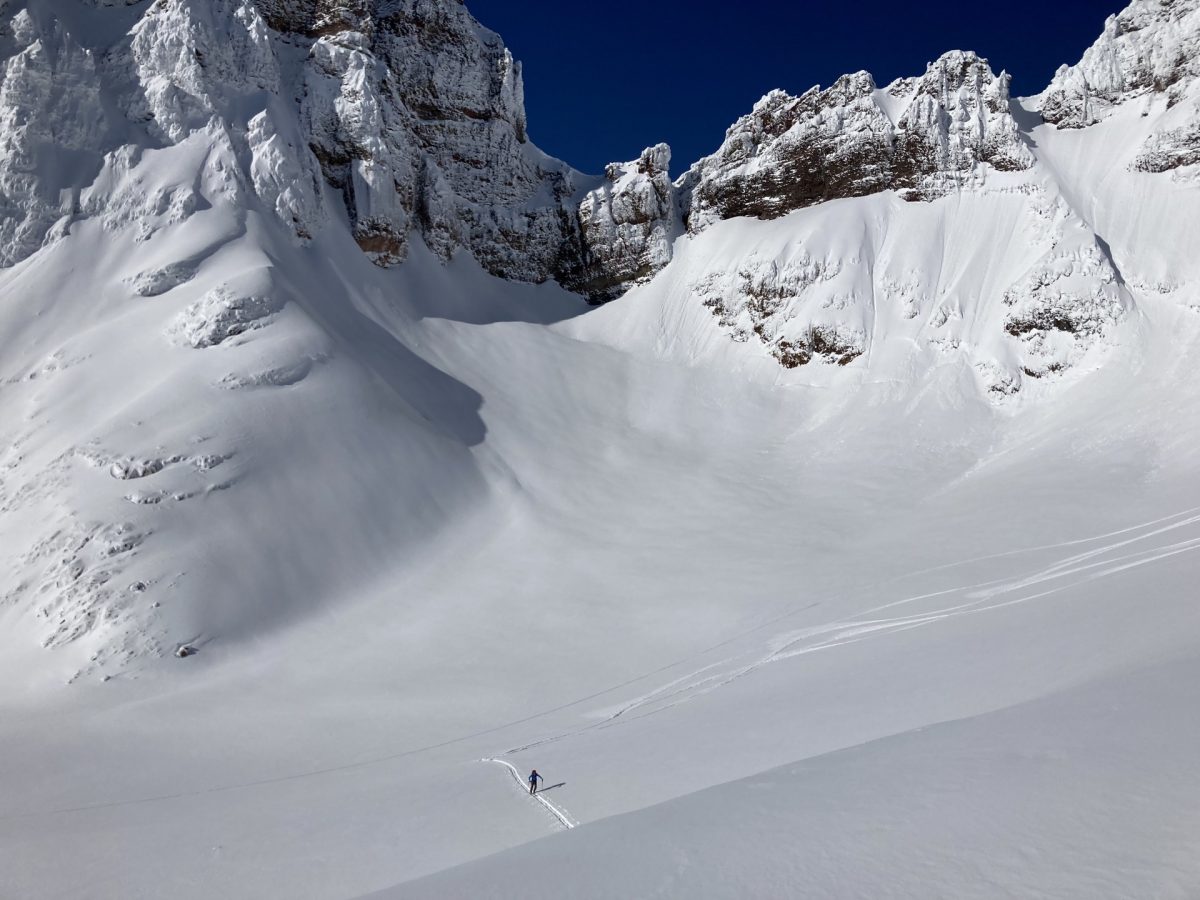
Far out on a big day, you want a reliable binding underfoot. We pair it down to four viable ski touring bindings options in this 22/23 Gear Guide.
If not the golden age of ski touring bindings, then it’s somewhere close to it. Consumers have many choices and numerous feature sets to consider when opting for a backcountry ski binding. We offer up four options in this ski touring binding gear guide that covers the full-spectrum from lightweight jewel to freeriding burly.
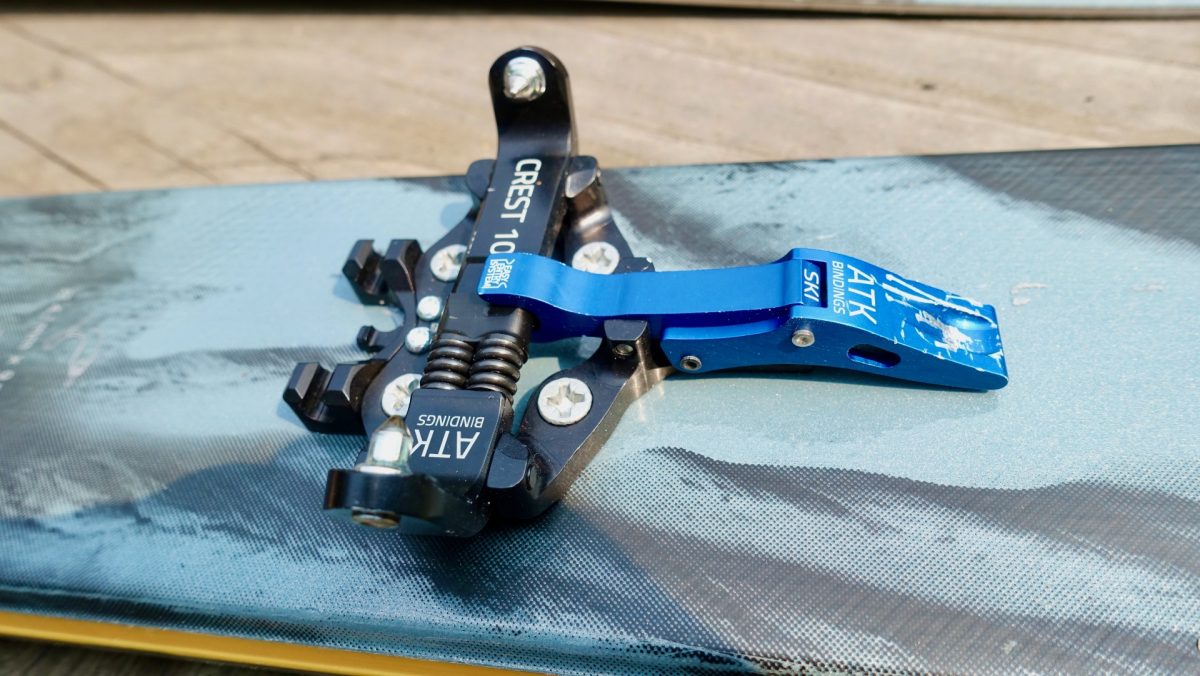
The ATK Crest 10 toe unit is simple in design and reliable in function. The crampon slot is detachable. The Crest 10 is a no nonsense binding for lightweight ski touring.
ATK Crest 10 Binding (w/ and w/out brakes)
Not long ago, in a ski town near you, there was one binding sheriff in town: Dynafit. With their tech binding patent expired, the marketplace blossomed with some excellent and substandard competition. Italy’s ATK offers many great additions to the binding smorgasbord at the local shop. The Crest 10 shows up with a full-spectrum feature set, lovely CNC machined aluminum, and scale tipping that meets a perfect middle-road between race grabber and full-value freeride huck-worthy bindings.
Let’s start with the not-so-shabby weight: 280g with brakes, ~220g without brakes. That’s in our sweet spot range. The Crest 10 also comes with a high and low riser and a flat mode; three options, which after many missions on the Crest 10s, cover the entire spectrum of riser height you’d want.
Some may see the following as an item for the gripes part of this, not us. Efficiency is part of the Crest 10’s game: keep the pins forward and flip the low riser over the pins, just like a skimo racer, skin up, flip the low-riser (26.5mm) back, stomp the heel, get ready for gravity. (Remember to pull skins somewhere in that transition routine.) Rotate the heel 180 degrees and stride away in flat mode. When the terrain kicks up, flip the highest riser (the tallest offering on this ATK model, but it’s not too high at ~40mm) into position and ascend. Maybe too granular for this best-of series, but going from flat mode to a solid riser option without rotating the heel builds transition and skin track efficiencies.
You’ll have to dig into a deeper review to get into the nitty-gritty engineering; know that it is solid. The toe piece locks the boot in with a crisp “click” while the heel enjoys the same notable security. The heel offers 20mm of adjustment; great if you’re someone who enjoys a boot quiver, or a few members of your clan use the same skis. The ski brake system is easy to engage and disengage, and these units arrive stock with an integrated ski crampon slot. (ATK units are compatible with Dynafit ski crampons.)
Now we get back to weight, which isn’t a burden. At ~280g, the heel has a vertical and lateral adjustability range of 5-10, while the toe piece offers a simple adjustable tension system for fine-tuning. The heel unit also has some elasticity built in for those hucking smaller items or experiencing ski flex because you rail so hard.
It all amounts to fine craftsmanship at a weight we applaud and a feature set to write home about.
Gripes
There’s always something to gripe about. But really, anything here is more nitpicky than a griping. We can see some hardwired backcountry skiers wanting to access the high and low riser options with the same heel orientation. Why not go flat mode, with low and high options right from there? We answered that question above; we think having a riser option from pins-forward, and flat, is elegant.
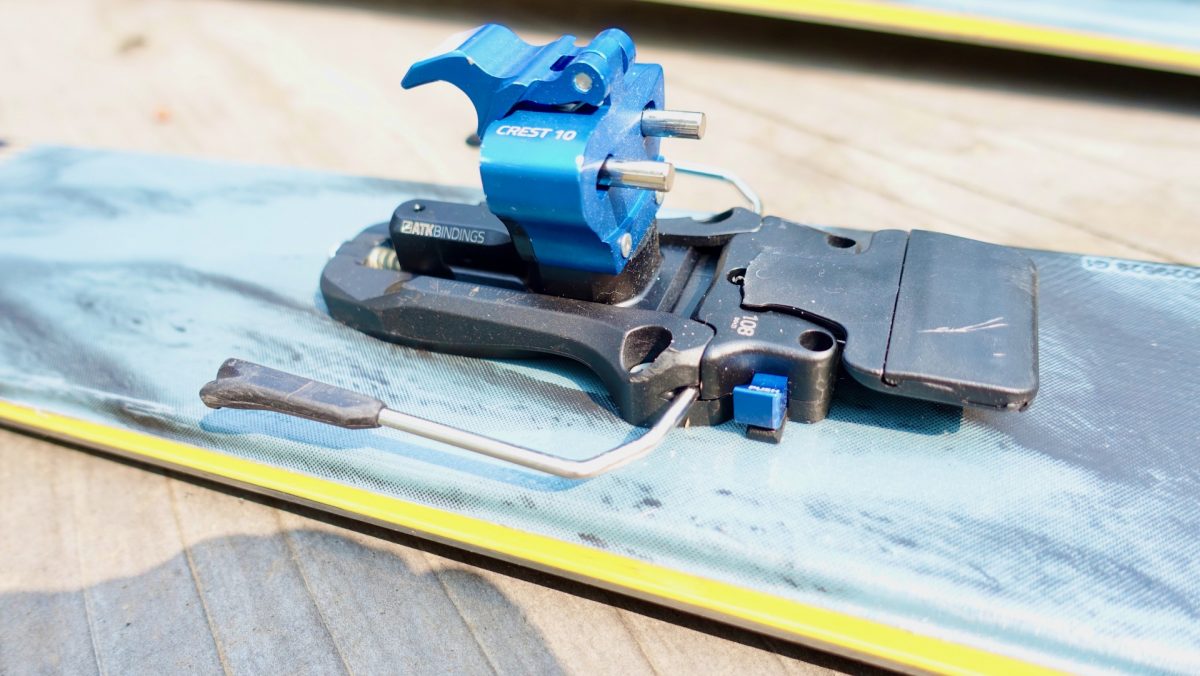
The heel unit of the Crest 10 features adjustable lateral and vertical retention and an easy to use single button to activate the breaks for descending.
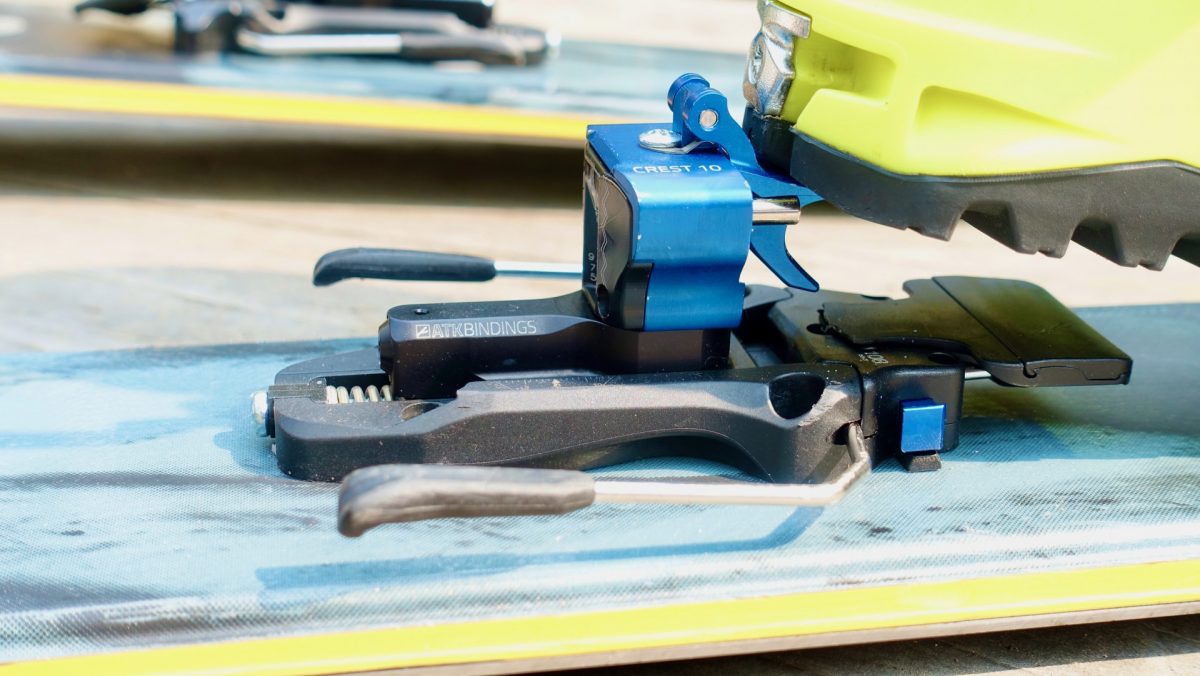
The Crest 10’s heel unit offers a flat mode, and two riser options.
Closing Thoughts
The Crest 10 is a practical binding with all the safety features we like to see, with a weight that is not a liability. The craftsmanship is evident in the flawless machined aluminum and a no-frills presentation. We’ve used these with and without brakes, and whatever direction you go, these are bindings you can count on deep in the mountains. This isn’t a Mack truck of bindings, so if big drops are in your future, seek a burlier binding out. And for those looking for a boot grabber with a slightly more refined feature set, you can opt for the ATK RT10, a similar binding offering magnetic risers. The RT will run you about $130 more. Otherwise, the Crest 10 is a kind touring binding for uphilling at the resort, powder skiing, or ski mountaineering adventures.
Weight: ~295g w/110mm brake.
Compatibility: Tech only
Brake Size Options: 75mm, 86mm, 91mm, 97mm, 102mm, 108mm.
Adjustment w/ heel plate: 20mm.
Risers: 2 + flat (get sizes)
Vertical release: 5-10.
Lateral release: 5-10.
Crampon slot: Included and is removable.
Price: $529.99.
Shop for the ATK Crest 10 binding.
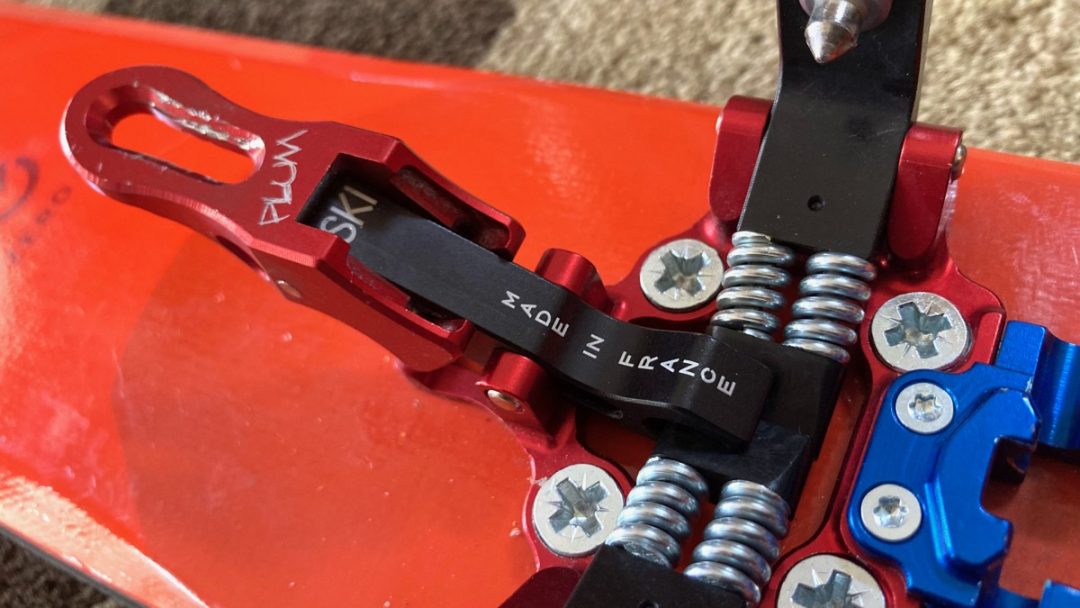
The Plum R170 toe with a time tested double spring on both sides of the pins. Toe plus heel unit arrives on the ski at 176g confirmed.
PLUM R170
The French can engineer. In the wide-open market that is tech bindings (well, maybe it’s semi-wide open, PLUM arrives with an incredible lightness of being and locked in security to oggle. And perhaps the most oggle-worthy binding from these folks is the race-inspired R170. The toe piece is no flimsy might-get-you-up-and-down the local skimo race affair; the machined aluminum is stout, the springs robust, and the audible “click” when you press the boot is reassuring. The heel is on the minimalist side, with a non-adjustable U-spring that PLUM calls an 8 in vertical and lateral release.
At 176g confirmed, this binding should appeal to those looking to nab plum line steep descents that require some major calorie burning to access. With a recently re-tweaked toe piece and a steel U-spring, for a lightweight binding, they have stood the test of time and the test of many charging skiers in the no-fall-zone.
The R170 arrives with an aluminum heel adjustment plate, so those using multiple styles of boot on the same ski can rejoice. Although the adjustment plate speaks of highfalutin features, don’t be fooled, it has a single riser (+41mm) and a flat mode. If steep and icy skinning is your jam, which it likely is with a binding like this, you’ll have to add a ski crampon slot (which is easy to do).
Gripes
This is not your full-featured freeride huck-momma. But we know that. A small gripe is that you’ll have no access to a riser while touring in flat mode. For flat mode, spin the heel 90 degrees from pins forward to access while touring, and to access a riser, spin it back another 90 degrees. Another gripe for smaller or larger skiers, the U-spring, set at 8, does not come in an assortment of spring tensions.
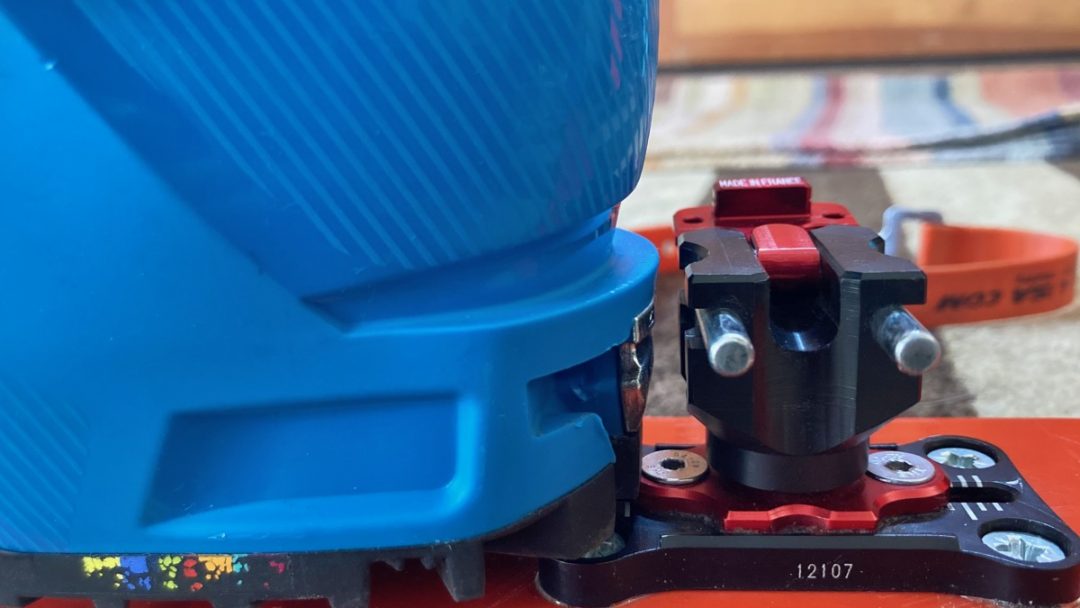
The PLUM R170 rotated 90 from pins forward for a flat mode skinning option.
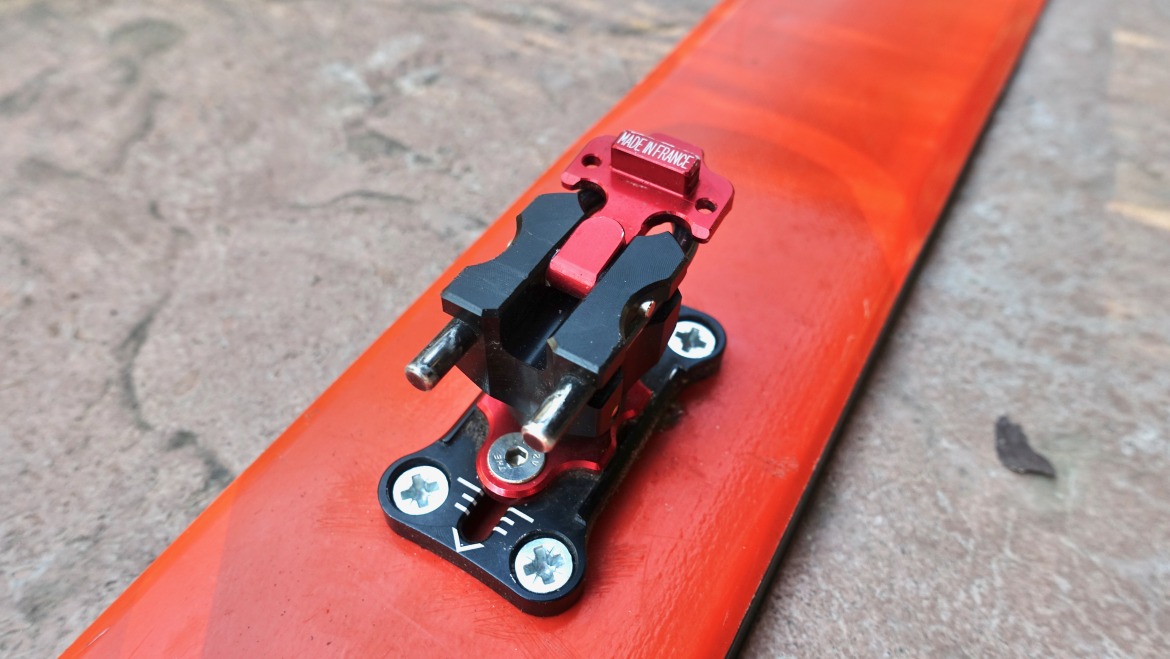
Pins forward, ready for engagement. Th R170 heel unit is a race style piece with a flat mode and +41mm riser option.
Closing Thoughts
Ski mountaineering has become fashionable of late. As in, “yeah, we’re ski mountaineering; I’m going to ding up the new axe today.” But if your axes sport dull picks from overuse, and you sometimes use a crampon’s front point as a spoon, this binding is the real deal in that it fuses the “ski” with the “mountaineering,” not necessarily the ski with the mo. The R170 is a trusty binding that, although race-inspired, is deeply mission-worthy. Lock in and harness the lightness without skimping on the security.
Weight: 176g/binding.
Compatibility: Tech only.
Brakes: No brake options, leash only.
Adjustment plate: +/- 10mm of adjustability.
Vertical release value: fixed at 8.
Lateral release value: fixed at 8.
Riser positions: Flat & +41mm.
Crampon Slot: Not included, removable.
Price: MSRP $475
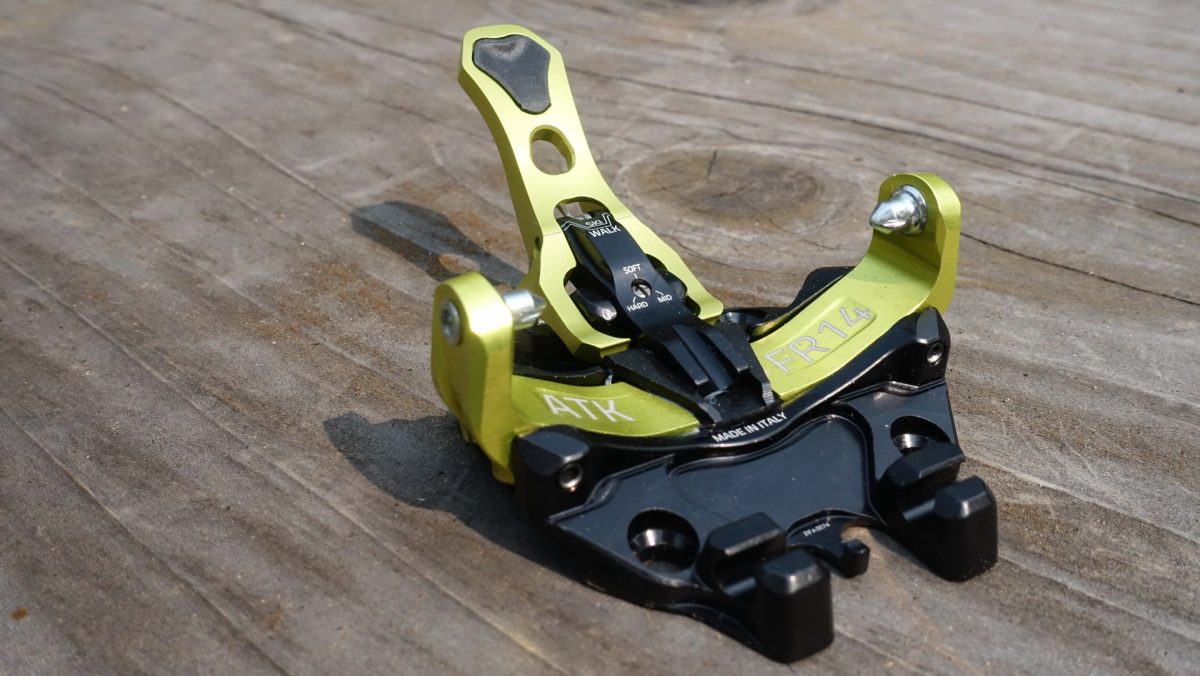
ATK’s Freeraider 14 toe unit: elegant and freeride worthy too. The toe unit features adjustable retention when pulled up into walk mode.
ATK Freeraider 14
ATK has gloriously come on the scene; they have populated the market with mindful additions to the tech-binding universe. If you’re a backcountry skier keen on saying things like, “3-2-1 (fill in your name here)…dropping!!” then the Freeraider 14 should be part of your touring binding quiver. Like their entire line of bindings, the Freeraider 14 has the highest quality and build. But what we see in the Freeraider series (it also comes in a 14 and 16 variety, with the difference only in the vertical and lateral release values) is a binding able to handle those who choose to ski big lines aggressively, with the occasional huck and landing thrown in for good measure. The Freeraider 14 is full-featured relative to what we usually review here on WildSnow: these bindings come equipped with brakes, four different riser options (+ a flat mode), adjustable vertical and lateral releases, an adjustable system to dial in the locking hardness for the toe piece, a 25mm adjustable heel, and a heel unit with built-in elasticity for those hitting funky snow at high speeds or bending the time-space continuum while shredding.
There is still more — remember, this is a full-featured tech binding. The heel unit comes with a freeride spacer. The spacer is a wedge of molded plastic that sits under the ski boot’s heel. When you insert the heel pins, rather than have the full force of the skier and their power-skiing generated forces sitting in the heel pins, the boot’s heel sits on the spacer too. ATK says the freeride spacer enhances the boot’s power transfer and torsional rigidity: anecdotally, we hear the spacer provides positive sensations.
Gripes
Where to gripe here? That’s a tough one. If you enter the shop eyeing a freeride type touring binding, you’re going way beyond the 200g threshold in mass. In the Freeraider 14, you can keep it all under 400g. That’s still some heft, but freeriders need some heft. The only gripe comes from the perspective of simplicity; there sure are a lot of riser options available. But that’s likely the least of your concerns. Make sure you nail the landing when you feel some measurable air between you and the snow.
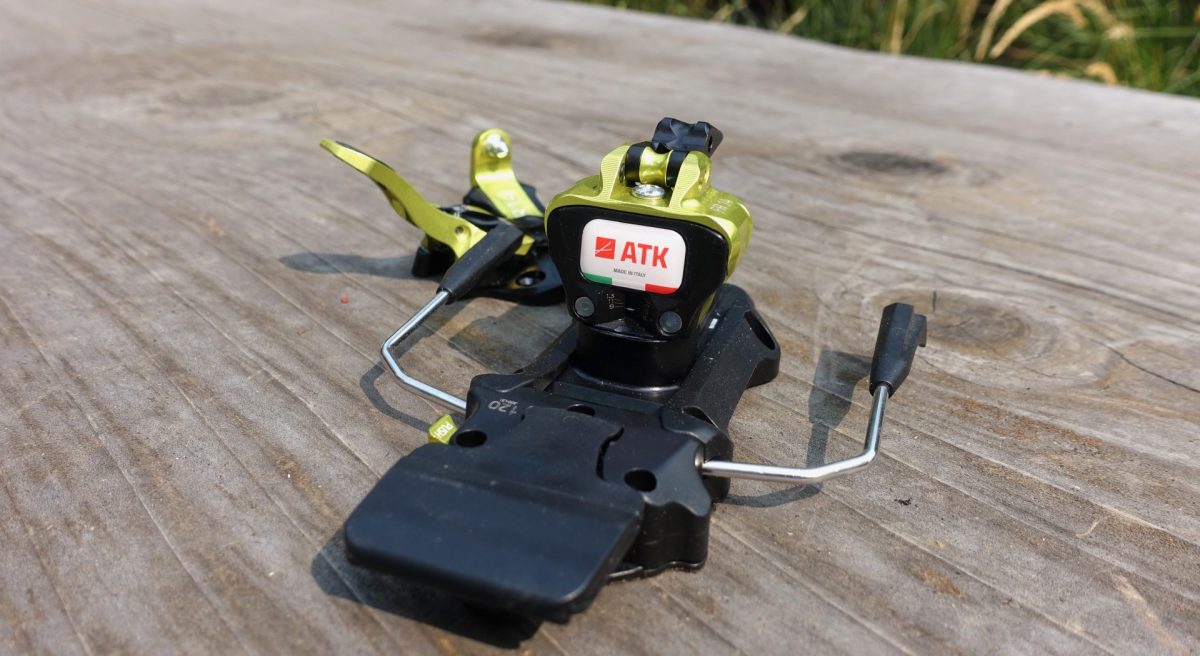
The Freeraider 14’s heel unit offers a generous four riser options including a flat mode. Shown here, the heel unit is turned 180 degrees from pins forward.
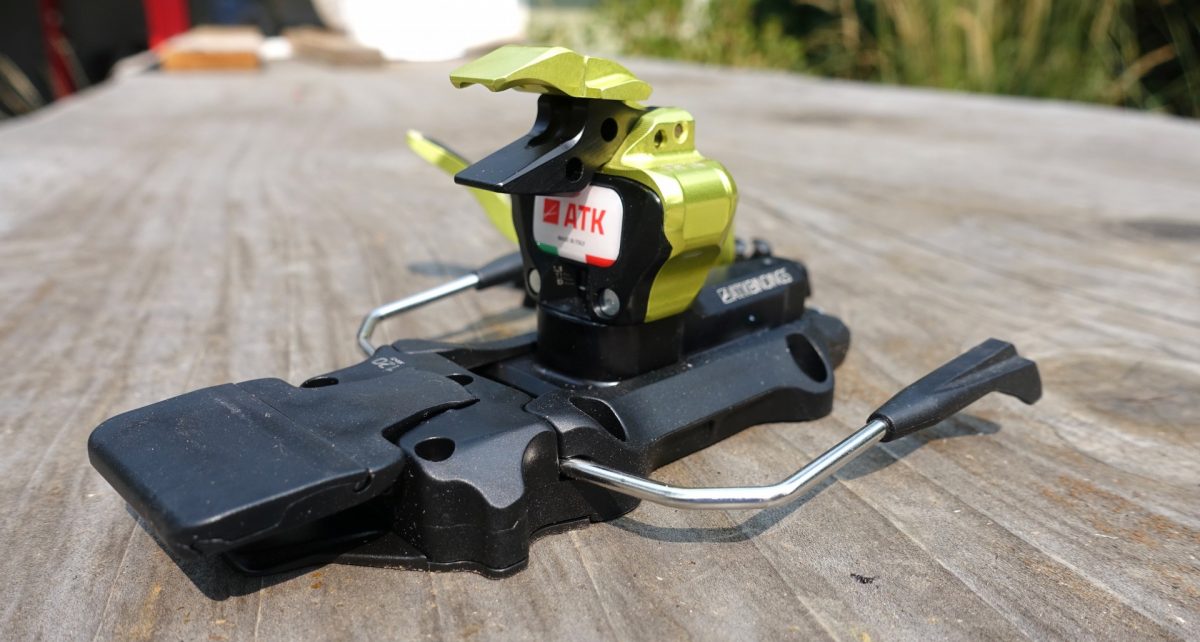
The Freeraider 14’s heel unit in a similar orientation with both heel both risers flipped forward.
Closing Thoughts
The Freeraider 14 is an elegant beast. It’s the type of beast that has you covered in terms of heel and toe retention on those aggressive days and still, for the strong among us (you know who you are), can haul up nearly 400g per ski of highly engineered binding grace. The Freeraider 14 is not for everyone; we’ve likely outlined that above. If you’re an aggressive skier but, for the most part, are not airborne during your ski day, you can save some weight and go with a more minimalist binding. But for a full-featured tech binding that can handle all you throw at it, the Freeraider 14 can give you some ease of mind when the skiing gets sporty and dicey.
Weight: Full featured (w/screws) 392g
Compatibility: Tech only.
Brakes: 97mm, 102mm, 108mm, 120mm.
Vertical release value: 8-14.
Lateral release value: 8-14.
Riser positions: Flat + four riser heights.
Crampon Slot: Included/non-removable.
Price: $749.99
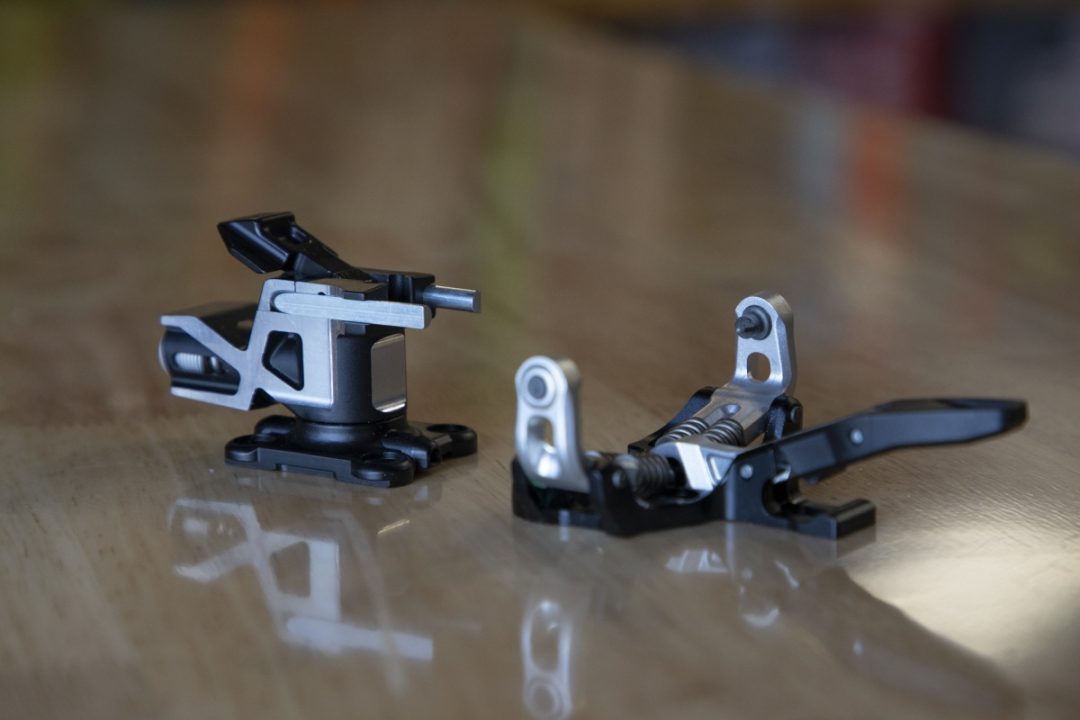
The Dynafit Superlite 150: A tasty minimalist design with the retention we expect from beefier bindings.
Dynafit Superlight 150
Synonymous with tech binding, Dynafit’s Superlight 150 brings the Austrian brand’s know-how in a race-bred tour-lite combo. That’s a lot of hyphenated words strung together, and thankfully, the Superlight 150 is more minimalist. This binding works for those seeking a feathery tech binding with the retention to hold fast and firm when the turns count. This means consequential firm terrain. Another upshot for weight-conscious skiers is the Superlight 150 is prime goods to mount on a powder board. We see more skiers each year adopting the ethos of less is more when hauling a heavier ski. So yes, the SL 150 can be a viable option for those looking to lighten up the overall weight of a ski when considering the ski+binding+skin.
The SL 150 trends towards full features with an emphasis on remaining lean. The overall weight without brakes is ~160g and without an optional heel adjustment plate. The lateral release adjusts between 4-13; with the vertical release fixed at either 6 or 8, depending on the specified U-spring. (The SL 150 comes with the 8 spring; you can purchase the 6 separately.) Both the 8 and 6 U-springs are steel for added durability.
For risers, sans brakes, skiers are afforded a flat mode and a low and high riser adjustment. Flip the riser over the pins (pins forward) like a race-oriented binding to engage the high riser. To use the low riser, twist the heel 180-degrees. Option flat mode by turning the heel unit 90-degrees from pins forward. Riser heights are 29mm and 49mm, respectively.
Gripes
All that twisting of the heel unit is the gripe. The pins forward higher riser option is ideal for those looking for quick transitions and simplicity. In rolling terrain, optioning the different risers and the flat mode will motivate you to become more flexible. You’ll be bending over and twisting the heel frequently if you aim to dial in the ideal riser: angle grade ratio. And if you add brakes, you lose the high riser (race touring mode) and flat mode. Look elsewhere if you want a light binding and brakes.
Closing Thoughts
The SL150 is a fine little unit with big capabilities. Dynafit is a trusted name, and the SL 150 builds on that trust with excellent craftsmanship/design, all while offering a solid feature set at minimal weight. Retention in the SL 150 is strong, have no fear of the svelte package under your feet.
Weight: 160g
Compatibility: Tech only.
Brakes: leashes only, but a new “plus” version is available with brakes in 75mm, 90mm, and 105mm.
Vertical release value: option for 8 or 6 (depending on u-spring selected).
Lateral release value: adjustable 4-13.
Riser positions: Flat + 2 riser heights (no brakes).
Crampon Slot: Included and removable.
Adjustment Plate: optional, but bumps the overall weight to ~200g.
Price: $599.95 with no brakes, $699.95 with brakes.
Buy the Dynafit Superlight 150.
While most of the WildSnow backcountry skiing blog posts are best attributed to a single author, some work well as done by the group.
